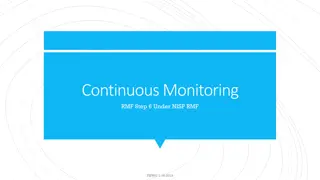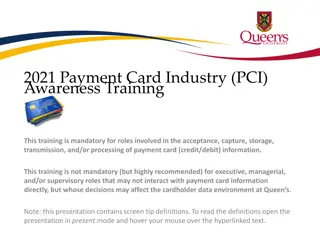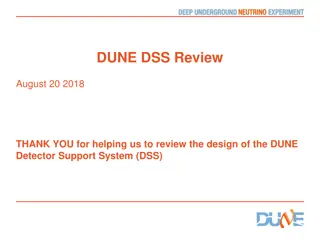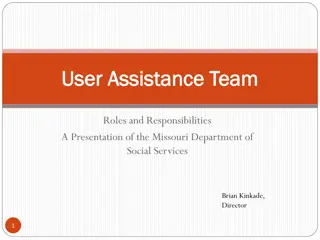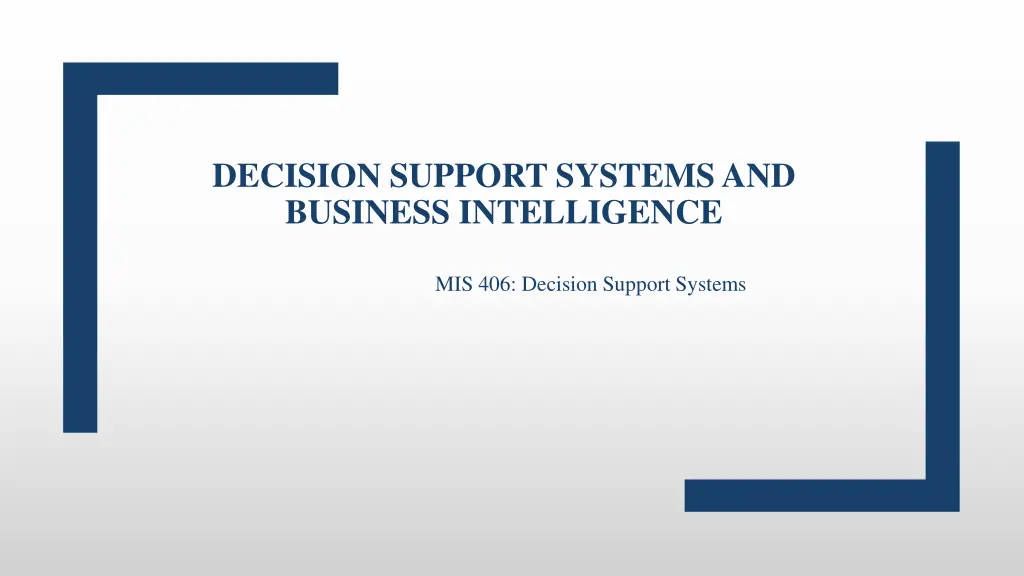
Business Decision Making and Managerial Roles in Organizations
Explore the process of decision-making in business management, encompassing decision support systems, cost analysis models, and the complexities that managers face. Delve into Mintzberg's 10 managerial roles and the challenges presented by technological advancements, globalization, and regulatory environments.
Download Presentation

Please find below an Image/Link to download the presentation.
The content on the website is provided AS IS for your information and personal use only. It may not be sold, licensed, or shared on other websites without obtaining consent from the author. If you encounter any issues during the download, it is possible that the publisher has removed the file from their server.
You are allowed to download the files provided on this website for personal or commercial use, subject to the condition that they are used lawfully. All files are the property of their respective owners.
The content on the website is provided AS IS for your information and personal use only. It may not be sold, licensed, or shared on other websites without obtaining consent from the author.
E N D
Presentation Transcript
DECISION SUPPORT SYSTEMS AND BUSINESS INTELLIGENCE MIS 406: Decision Support Systems
Managerial Decision Making Management is a process by which organizational goals are achieved by using resources Inputs: resources Output: attainment of goals Measure of success: outputs / inputs Management Decision Making Decision making: selecting the best solution from two or more alternatives
The nature of managers work Mintzberg's 10 Managerial Roles Interpersonal 1. Figurehead 2. Leader 3. Liaison Decisional 7. Entrepreneur 8. Disturbance handler 9. Resource allocator 10. Negotiator Informational 4. Monitor 5. Disseminator 6. Spokesperson
The process of decision making Managers usually make decisions by following a four-step process (the scientific approach) 1. Define the problem (or opportunity) 2. Construct a model that describes the real-world problem 3. Identify possible solutions to the modeled problem and evaluate the solutions 4. Compare, choose, and recommend a potential solution to the problem
The process of decision making y= mx + c Total cost= variable cost per unit production unit+ fixed cost Solution model for the problem of finding the minimum total cost.
Decision making is difficult, because Technology, information systems, advanced search engines, and globalization result in more and more alternatives from which to choose Government regulations and the need for compliance, political instability and terrorism, competition, and changing consumer demands produce more uncertainty, making it more difficult to predict consequences and the future Other factors are the need to make rapid decisions, the frequent and unpredictable changes that make trial-and-error learning difficult, and the potential costs of making mistakes
Information Systems Support for Decision Making (why use computerized decision support?) Group communication and collaboration Improved data management Managing data warehouses and Big Data Analytical support Overcoming cognitive limits in processing and storing information Knowledge management Anywhere, anytime support
An Early Framework for Computerized Decision Support (The Gorry and Scott-Morton Classical Framework)
An Early Framework for Computerized Decision Support (The Gorry and Scott-Morton Classical Framework) Degree of Structuredness (Simon, 1977) Decision / Decision making process are classified as Highly structured ( programmed) Semi-structured Highly unstructured (i.e., non-programmed) Types of Control (Anthony, 1965) Strategic planning (top-level, long-range) Management control (tactical planning, mid-level) Operational control (low-level)
An Early Framework for Computerized Decision Support (The Gorry and Scott-Morton Classical Framework) Types of control in all managerial activities Strategic planning Defining long range of goals and policies for resource allocation Management control Acquisition and efficient use of resources for organizational goal Operational control Efficient and effective execution of specific task. The decision support matrix For semi-structured decisions and unstructured decisions, conventional MIS and MS (mgt Sc) tools are insufficient Decision support systems (DSS) are used for unstructured problems.
Computer Support for Structured Decisions Structured problems: encountered repeatedly, have a high level of structure. It is possible to abstract, analyze, and classify them into specific categories e.g., make-or-buy decisions, capital budgeting, resource allocation, distribution, procurement, and inventory control For each decision category, an easy-to-apply prescribed model and solution approach have been developed, generally as quantitative formulas. Therefore, a scientific approach can be used to automate portions of managerial decision-making.This process is called Management Science
Computer Support for Unstructured Decisions Unstructured problems can be only partially supported by standard computerized quantitative methods They often require customized solutions They benefit from data and information from corporate or external data sources. Intuition and judgment may play a role in this decision Computerized communication and collaboration technologies, along with knowledge management, are often used.
Computer Support for Semi-structured Problems Solving semi-structured problems may involve a combination of standard solution procedures and human judgment MS handles the structured parts, while DSS deals with the unstructured parts DSS can improve the quality of information on which decision is based by providing various alternative solutions and their potential impacts. Thus, to make better decisions.
Concept of Decision Support Systems A Decision Support System is an interactive computer-based system or subsystem that helps people use computer, communications, data, documents, knowledge and models to identify and solve problems, complete decision process tasks, and make decisions. Decision support systems are computer-based systems that bring together information from a variety of sources, assist in the organization and analysis of information, and facilitate the evaluation of assumptions underlying the use of specific models. In other words, these systems allow decision makers to access relevant data across the organization as they need it to make choices among alternatives.
Types of DSS Two major types: Model-oriented DSS quantitative models used to generate a recommended solution to a problem. These are used by managers and staff members of a business, or people who interact with the organization, for a number of purposes depending on how the model is set up - scheduling, decision analyses, etc. Data-oriented DSS support ad-hoc reporting and queries. Examples: computer-based databases that have a query system to check (including the incorporation of data to add value to existing databases.
Uses of a Decision Support System Generally, it is accepted that DSS technology is warranted if the goal is to help decision-makers: Look at more facets of a decision Generate better alternatives Respond to situations quickly Solve complex problems Consider more options for solving a problem Brainstorm solutions Utilize multiple analyses in solving a problem Have new insights into problems and eliminate "tunnel vision" associated with premature evaluation of options Implement a variety of decision styles and strategies Use more appropriate data Better utilize models Consider "what if?" analyses
Evolution of DSS into Business Intelligence Use of DSS moved from specialist to managers, and then whomever, whenever, wherever. Enabling tools like OLAP, data warehousing, data mining, intelligent systems, delivered via Web technology have collectively led to the term business intelligence (BI) and business analytics . BI is an evolution of decision support concepts over time Then: Executive Information System Now: Everybody s Information System (BI) BI systems are enhanced with additional visualizations, alerts, and performance measurement capabilities The term BI emerged from industry
Definition of Business Intelligence (BI) Business intelligence (BI) is a set of theories, methodologies, processes, architectures, and technologies that transform raw data into meaningful and useful information for business purposes. BI can handle large amounts of information to help identify and develop new opportunities.
A High-Level Architecture of BI BI system has four major components- 1. Data warehouse 2. Business Analytics 3. Business process management 4. User interface
A High-Level Architecture of BI 1. Data warehouse The data warehouse is a large repository of well-organized historical data Today, some data warehouses include current data as well, so they can provide real time decision support
A High-Level Architecture of BI 2. Business analytics Business analytics are the tools that allow transformation of data into information and knowledge Reporting and queries Data mining A process of searching for unknown relationships or information in large databases or data warehouses, using intelligent tools such as neural computing, predictive analytics techniques, or advanced statistical methods
A High-Level Architecture of BI 3. Business performance management (BPM) (BPM) allows monitoring, measuring, and comparing key performance indicators An advanced performance measurement and analysis approach that embraces planning and strategy
A High-Level Architecture of BI 4. User interface User interface (e.g., dashboards) allows access and easy manipulation of other BI components Includes dash boards and other information broadcasting tools: Dashboard- A visual presentation of critical data for executives to view. It allows executives to see hot spots in seconds and explore the situation. Dashboards integrate information from multiple business areas Visualization tools
The Major Tools and Techniques of Managerial Decision Support TOOL CATEGORY Data management Reporting status tracking Visualization Business analytics Strategy and performance management Communication and collaboration Social networking Knowledge management Intelligent systems Enterprise systems TOOLS AND THEIR ACRONYMS Databases and database management system (DBMS) Extraction, transformation, and load (ETL) systems Data warehouses (DW), real-time DW, and data marts Online analytical processing (OLAP) Executive information systems (EIS) Geographical information systems (GIS) Dashboards, Information portals Multidimensional presentations Optimization, Web analytics Data mining, Web mining, and text mining Business performance management (BPM)/ Corporate performance management (CPM) Business activity management (BAM) Dashboards and Scorecards Group decision support systems (GDSS) Group support systems (GSS) Collaborative information portals and systems Web 2.0, Expert locating systems Knowledge management systems (KMS) Expert systems (ES) Artificial neural networks (ANN) Fuzzy logic, Genetic algorithms, Intelligent agents Enterprise resource planning (ERP), Customer Relationship Management (CRM), and Supply-Chain Management (SCM) Source: Table 1.4 Computerized tools for decision support










